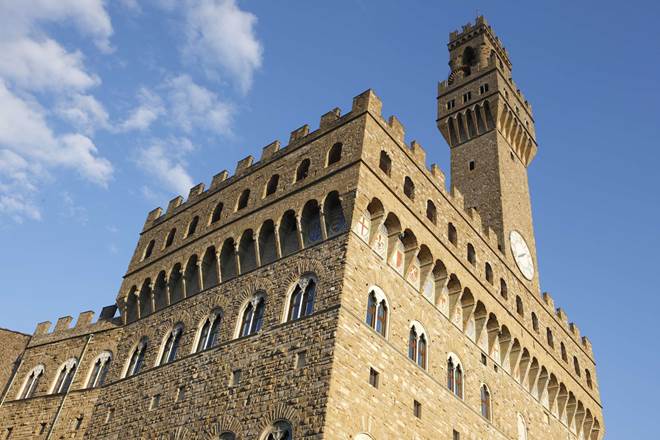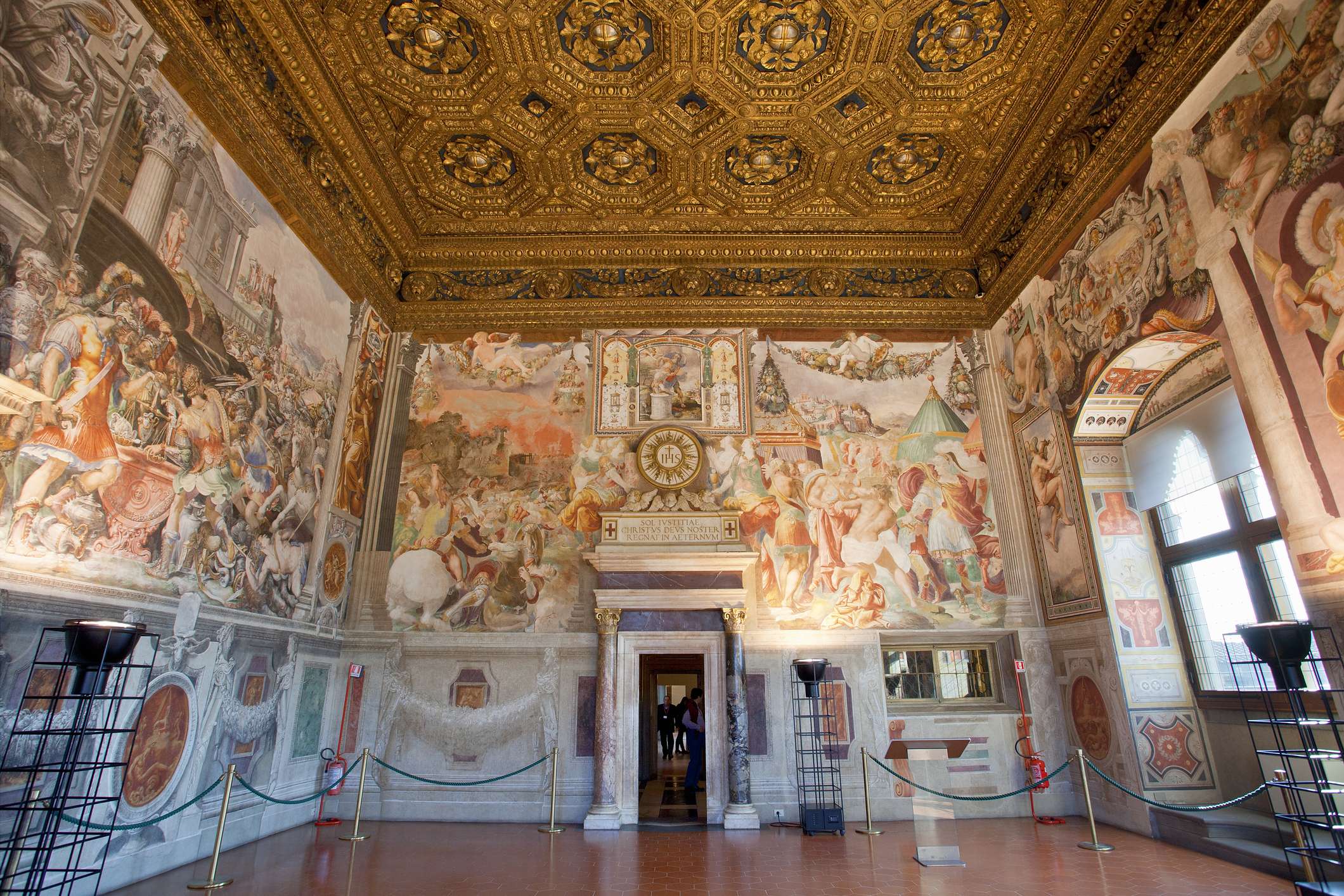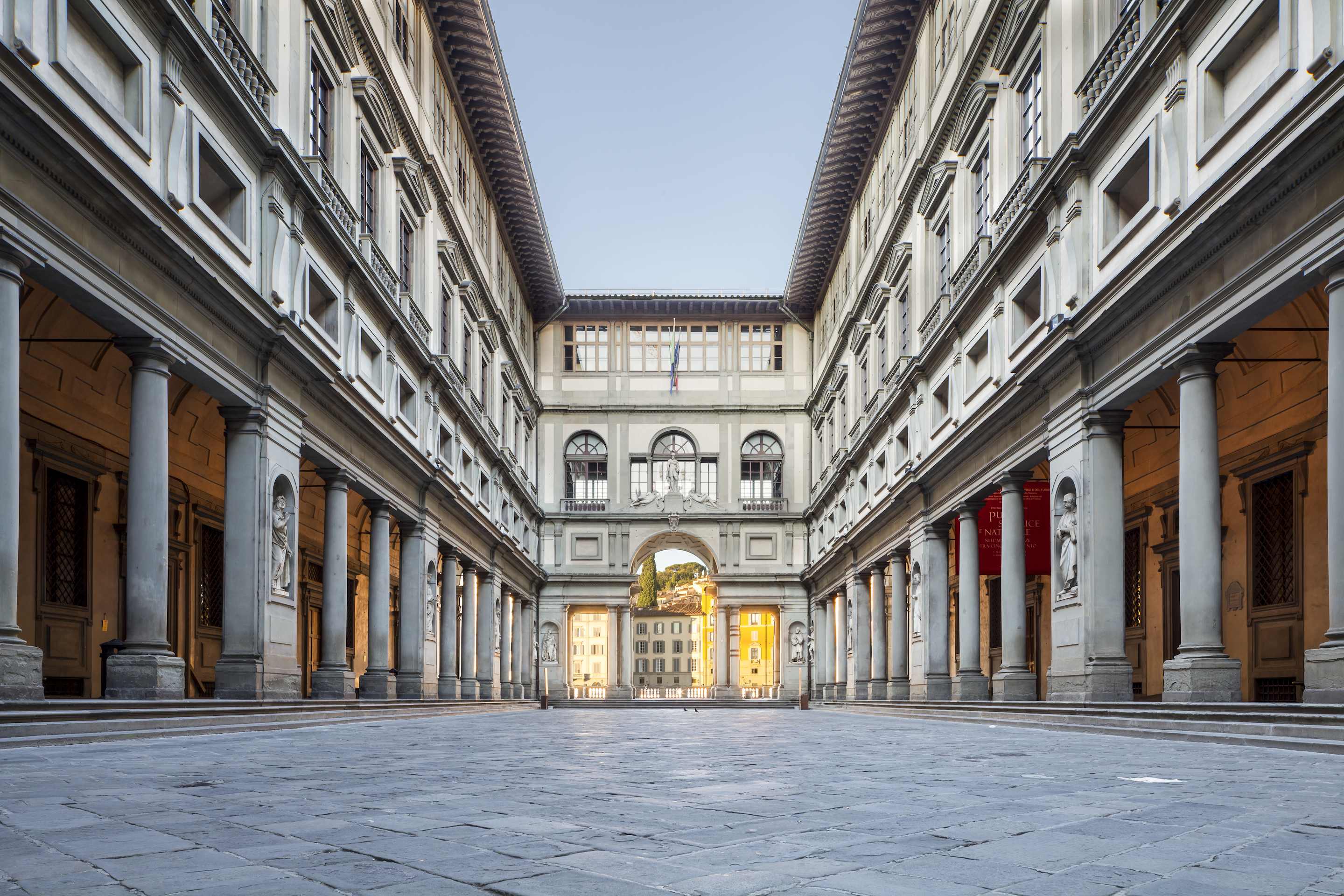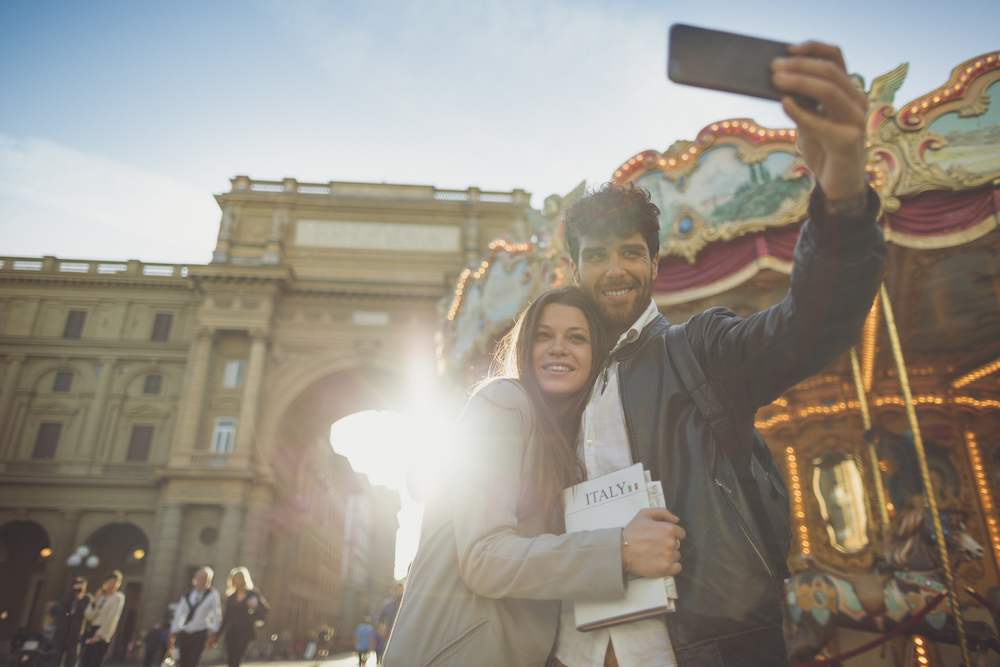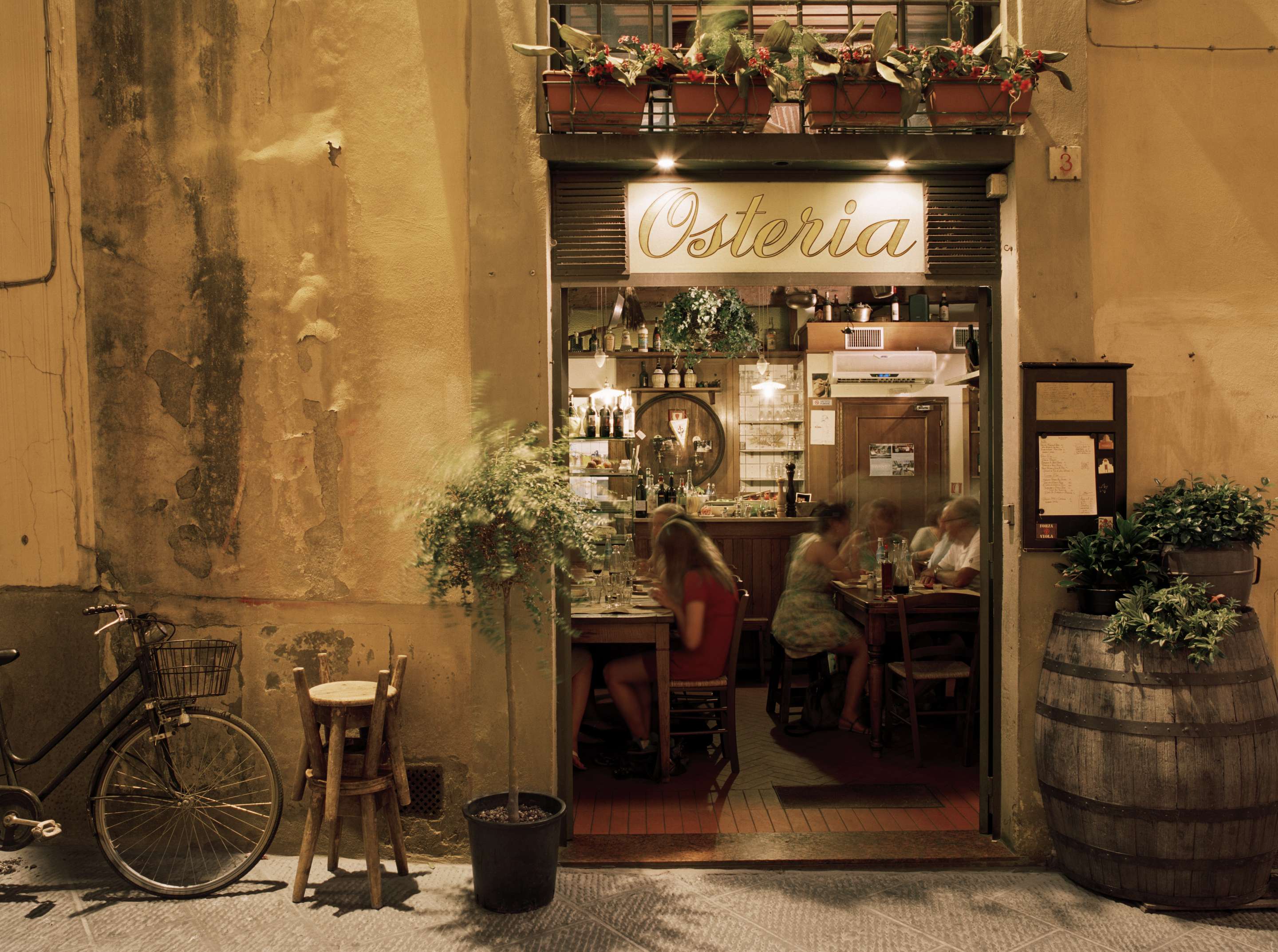When visiting Florence, you won’t want to miss Palazzo Vecchio. The medieval palace is one of Florence’s oldest and most popular attractions, located in Piazza della Signoria at the heart of the city centre.
Find out everything you need to know about visiting Palazzo Vecchio in our guide, including:
- Taking the train to Florence
- Palazzo Vecchio history and facts
- What to see at Palazzo Vecchio
- Restaurants, bars and shops near Palazzo Vecchio
- Opening times and prices
Taking the train to Florence
Take the train to Florence’s central station, Santa Maria Novella, where you’ll be a 16-minute walk from Palazzo Vecchio.
As Florence is a relatively small city, it’s easy to make the most of the Tuscan capital’s rich history and culture. You can get around this beautiful region by train, with regular services from Pisa, Lucca, Siena, Arezzo and Bologna, arriving at Firenze Santa Maria Novella station.
Not staying in Tuscany? Visit Florence for a night or two and travel by train – it’s quicker than you might think! The fastest trains from Rome take around 1 hour 30 minutes, whilst the average journey from Milan is 1 hour 50 minutes. You can get to Florence from Venice in just over 2 hours on the fastest service, so why not extend your trip for a few days?
Palazzo Vecchio history and facts
The medieval palace was built in 1299 by Arnolfo di Cambio, the architect who designed the Cathedral of Santa Maria del Fiore. There was a conflict between the Guelfs and the Ghibellines across northern and central Italy. The people of Florence wanted a secure structure for their government.
The imposing exterior of Palazzo Vecchio makes it look like a castle, and it was designed with defence in mind. Battlements, arches and embrasures were included to reinforce the structure and provide safe places for its inhabitants to attack potential invaders.
The palace has a square configuration and is made of stone, with two rows of Gothic windows around the entire building. Decorative elements adorn the exterior, including bas-reliefs of the cross and Florentine lily, trefoils and painted coats of arms of the Florentine Republic. At over 94 metres high, the rectangular clock tower looks out over Florence, known as Torre d’Arnolfo after its designer.
Palazzo Vecchio has always been a political centre, from the medieval period to 1871, when the city was temporarily the capital of Italy. Since 1872 it has remained the town hall of Florence, where the mayor and city council have their offices.
Location
Palazzo Vecchio translates to ‘old palace’, but this wasn’t its original name. It was previously known as Palazzo della Signoria, Florence’s town hall and home to the signoria (government). It was renamed in 1540 when the first Grand Duke of Tuscany, Cosimo I de’ Medici, moved his residence across the river to Pitti Palace.
Palazzo Vecchio is located in Piazza della Signoria, a vast public square in the heart of Florence’s city centre. In front of Palazzo Vecchio, you can see many statues of prominent figures, including a replica of Michelangelo’s statue of David.
The Medici connection
The Medici had overwhelming political influence in Florence from the late 14th century, establishing themselves as de facto rulers. From 1569 onwards, they ruled under the Grand Duchy of Tuscany, replacing the Republic of Florence.
Almost everywhere you go in Florence, you can see evidence of this wealthy banking family, prominent patrons of the arts. They were responsible for commissioning many buildings, sculptures and paintings during the Renaissance period and long after. Many of the rooms and artworks you see at Palazzo Vecchio were commissioned by Medici rulers.
What to see at Palazzo Vecchio
Today, Palazzo Vecchio is best known for its Museo di Palazzo Vecchio museum. Walk around the medieval palace to explore Florence’s turbulent political past, from the formation of the Florentine Republic to life under Medici rule. You can also enjoy the stunning interiors and artworks at Palazzo Vecchio, including frescoes by Botticelli and Vasari.
First Courtyard
The first courtyard of Palazzo Vecchio was designed by Michelozzo in 1453. In the centre is a fountain made by Battista del Tadda with a sculpture, Putto with Dolphin, completed in 1476 by Andrea del Verrocchio. Water from Boboli Gardens is piped through the nose of the dolphin to create this striking feature.
The frescoes on the courtyard walls were painted by Giorgio Vasari in 1565 to celebrate the marriage of Francesco I de’Medici and Johanna of Austria, a member of the Habsburg monarchy. They depict various cities under Habsburg rule at the time, including Vienna, Innsbruck and Prague.
Hall of the Five Hundred
The Hall of the Five Hundred (Salone dei Cinquecento) is one of the grandest chambers in Palazzo Vecchio. At 52 metres long and 23 metres wide, the enormous hall was designed to seat the Grand Council of the Florentine Republic’s 500 members.
It was commissioned by the Dominican friar Girolamo Savonarola, who took over as leader of the Republic after the Medici were exiled and was built by Simone del Pollaiolo in 1494.
Giorgio Vasari enlarged the original hall years later so Grand Duke Cosimo I de’ Medici could hold his court in the chamber. Two unfinished frescoes were lost during the renovations: Michelangelo’s Battle of Cascina and the Battle of Anghiari by Leonardo da Vinci. Instead, other battle scenes were painted on the walls, depicting Florence’s victories over Pisa and Siena.
Perhaps the most impressive features in the Hall of the Five Hundred are the 39 ceiling panels that Vasari painted and installed. They represent scenes from Cosimo I’s life and rule and the city of Florence.
The Apartments
You can visit many apartments on the second floor of Palazzo Vecchio, including the Apartments of the Elements, the Priori (priors, representing the guilds of Florence) and Eleonora Toledo. Each apartment is richly decorated with artworks and frescoes from the Renaissance by artists such as Botticelli, Bronzino and Ghirlandaio.
In the Apartments of the Priori, you’ll find the Sala dell’Udienza (audience chamber), where meetings of the Priori were held. This room has some of the oldest decorations in Palazzo Vecchio, such as its carved gold ceiling made by Giuliano da Maiano between 1470 and 1476.
The Chapel of the Signoria is also within the Apartments of the Priori. It contains a reliquary of St. Bernard, to whom the chapel is dedicated. Ghirlandaio created stunning frescoes on the walls and ceiling to imitate mosaics.
Hall of Geographical Maps
During the 16th century, this room displayed maps and artefacts relating to science, astronomy, geography and time. Known as a guardaroba (guarda meaning to look), these types of spaces were popular for keeping precious objects.
The Hall of Geographical Maps (Stanza della Guardaroba) was commissioned by Cosimo I de’ Medici to safely store items in the Medici collection. He wanted the space to be constructed like a gallery, using wooden display cabinets so visitors to Palazzo Vecchio could view the collections.
Climb the Arnolfo tower
The bell tower is one of the oldest original features of Palazzo Vecchio. You can climb its 400 steps and enjoy spectacular views over Florence. This viewpoint isn’t usually as busy as the cathedral’s dome or Giotto’s Bell Tower, so it’s an excellent opportunity to avoid the crowds!
Things to do near Palazzo Vecchio
Palazzo Vecchio is close to many of Florence’s most popular attractions, so you can plan a culture-packed day and tick off a few places on your itinerary. Then, once you’re finished sightseeing for the day, enjoy the many restaurants, bars and shops nearby.
Some of the best things to do near Palazzo Vecchio include:
Uffizi Gallery
Next to Palazzo Vecchio, you’ll find the world-famous Uffizi Gallery, home to works by Italian Renaissance masters, medieval European art and classical sculptures from ancient Greece and Rome.
Ponte Vecchio
This medieval bridge is one of the most photographed pieces of architecture in Florence for a good reason! Enjoy views of River Arno from Ponte Vecchio, a 3-minute walk from Palazzo Vecchio.
Piazza della Repubblica
Visit one of Florence’s oldest public squares, Piazza della Repubblica, to enjoy a coffee in one of the nearby cafes whilst you take in the impressive architecture around you. Piazza della Repubblica is a 4-minute walk from Palazzo Vecchio.
Cathedral of Santa Maria del Fiore
Make sure you visit Florence’s stunning Gothic cathedral in Piazza del Duomo. This is one of the city’s most famous landmarks, so you won’t want to miss out. Walk there in 6 minutes from Palazzo Vecchio.
Restaurants, bars and shops near Palazzo Vecchio
Why not take time out from sightseeing to enjoy some retail therapy at the many shops near Palazzo Vecchio?
Got a busy day of sightseeing planned? Grab a bite to eat at a restaurant near Palazzo Vecchio before heading to the next stop on your itinerary, or unwind at one of the nearby bars.
Best shops near Palazzo Vecchio
There are plenty of shops near Palazzo Vecchio, from high street stores to independent retailers and luxury designer boutiques. The best shopping streets to visit are:
- Via dei Calzaiuoli
- Via Roma
- Via Calimala
- Via de’ Tornabuoni
- Via degli Strozzi
- Via della Spada
- Via della Vigna Nuova
Check out our dedicated shopping guide to find out more of the best places to treat yourself during your trip.
Best restaurants near Palazzo Vecchio
When it’s time to sit down and refuel, there’s plenty of choice near Palazzo Vecchio. Some of the best cafés and restaurants in the area are:
- Il Cernacchio
- I’ Girone De’ Ghiotti
- La Nicchietta in Calimaruzza
- Auditore Ristorante Braceria
- Trattoria Alfredo
- Trattoria Il Bargello
- Vini e Vecchi Sapori
- Buca Poldo
Best bars near Palazzo Vecchio
At the end of a busy day, head to a nearby bar where you can relax and enjoy Florence by night:
- La Petite
- Naima
- Mayday Club
- Il Vinile
- I’Margaritaio
- Angel Roofbar
Discover more of the best places to eat and drink in Florence in our dedicated restaurants and nightlife guides.
Palazzo Vecchio opening times and prices
The museum at Palazzo Vecchio is open daily from 09:00 to 19:00, except on Thursdays when it closes at 14:00.
Standard tickets cost €10*, whilst reduced-price tickets are available for EU citizens aged 18 to 25, costing €8*. Free entry is granted to those who meet specific criteria, including children under 18, disabled visitors and Firenze cardholders.
Like many of Florence’s attractions, Palazzo Vecchio can get busy, so it’s best to book your tickets online where possible. Tickets are also available at the museum’s box office.
Prices correct as of February 2022
